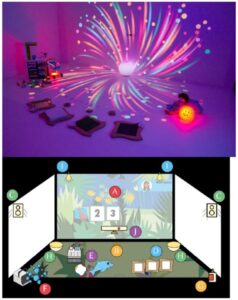Seminar Blogs
“Interactive Multi-Sensory Environments and Their Utilization in Education” – Polyniki Katrantsioti
Education and technology have been intertwined ever since the first burst of technological advancements and their dynamic entrance into the educational system. In light of the discussion held in the last Transmission in Motion seminar I would like to discuss the emergence of interactive multi-sensory environments (iMSEs) their use in primary school education, and the strengths and weaknesses they seem to possess.
“Interactive Multi-Sensory Environments are room-sized interactive installations equipped with digitally enriched physical materials and ambient embedded devices” (Garzotto, Beccaluva, Gianotti and Ricardi 2020, 1). They provide their users with a variety of sensory triggers and are mostly used for educational or therapeutic goals and are popular among people with “severe cognitive and or motor impairments” (Garzotto, Beccaluva, Gianotti and Ricardi 2020, 1). IMSEs can take a variety of forms, such as the MEDIATE environment, Lands of Fog, Sensory Paint, and the Magic Room, that can stimulate different senses and parts of the brain, while also providing the educator with a variety of different activities to carry out in the classroom (Garzotto, Beccaluva, Gianotti and Ricardi 2020, 2-3). The use of iMSEs is revolutionary in the way that it both benefits children with motor and cognitive disabilities but can also be used in classrooms as a tool to enhance and sharpen creative skills in the school environment. Using the Magic Room as a focus point it has been proven that it “provides a wealth of interactive multisensory activities for children that seems to keep them engaged not just sporadically but for many sessions and for long periods” (Garzotto, Beccaluva, Gianotti and Ricardi 2020, 2).

Beccaluva, Eleonora, Garzotto, Franca, Giannoti, Matia, and Riccardi, Fabiano. 2020. “Interactive Multisensory Environments for Primary School Children”. In Proceedings of the 2020 CHI Conference on Human Factors in Computing Systems (CHI ’20). 1-12. New York: Association for Computing Machinery. https://doi.org/10.1145/3313831.3376343
However, it is important to note that as with all technological advancements that enter the school environment, one should be aware of the limitations that accompany them. The first issue that should be mentioned is the capability of the teachers to take part in such activities. “The teacher’s role is to plan and control the use of the [multi-sensory environment] to provide passive stimulation and opportunity for the child to relax and explore” (Stephenson and Carter 2011, 1). This kind of engagement on the part of the teacher requires specific training and knowledge on the use of iMSEs. Additionally, another factor that should be taken into account is the construction and organization of such spaces to achieve the best possible outcome in triggering sensory functions in students.
Overall, the topic on the use of interactive multisensory environments is a multifaceted one since on the one hand, they could be beneficial to enrich the current state of the educational system into creating a creative and interactive classroom environment, but there is also a need for empowerment of the spatial environment and the teacher to ensure the correct usage and proper engagement of the students.
References:
- Beccaluva, Eleonora, Garzotto, Franca, Giannoti, Matia, and Riccardi, Fabiano. 2020. “Interactive Multisensory Environments for Primary School Children”. In Proceedings of the 2020 CHI Conference on Human Factors in Computing Systems (CHI ’20). 1-12. New York: Association for Computing Machinery. https://doi.org/10.1145/3313831.3376343,
- Carter, Mark and Stephenson, Jennifer. 2011. “Use of Multisensory Environments in Schools for Students with Severe Disabilities: Perceptions from Schools.” Education and Training in Autism and Developmental Disabilities 46, no.2 (June): 276-290. https://www.jstor.org/stable/23879697.

